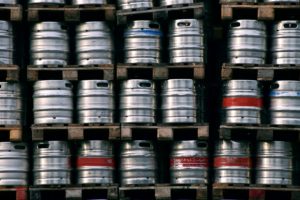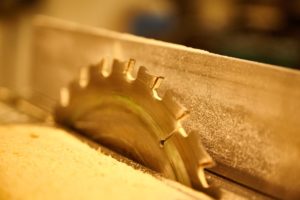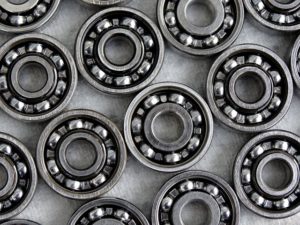There are very many industries in which electrolytic marking is carried out. Basically, the electrolytic marking process can be used wherever metal needs to be marked.
It is particularly popular in the following industries / application areas:
Knife and cutlery industry

The electrolytic marking process developed a few decades ago with the knife and cutlery industry. Even today, the majority of kitchen knives, scissors, cutlery and other utensils are marked electrolytically.
Cost-effectiveness is not the only factor that outweighs other processes; the hygiene aspect also plays an important role. Electrochemical marking is created in such a way that no bacteria or germs can get trapped within it. Additionally, the corrosion resistance and the viewing angle stability of the mark offer a clear advantage over laser marking.
Stainless steel KEG / beer barrel lettering

In contrast to marking with coloured ribbons or fitting lids, the electrolytic marking on KEGs is decorative and very effective for advertising. The electrolytic marking is wear-resistant and adorns the KEG permanently.
These generally large-area marks cannot be applied as quickly with any other marking method as with the electrolytic method. The stencils used are flexible and can easily be placed over the circumference.
Medical & surgical instruments

Surgical instruments must be labeled – of course with a hygienically perfect mark. Electrolytic marking fulfills this requirement and can still be read perfectly even after many sterilization processes.
The electrolytic direct marking of data matrix codes on scissors, scalpels etc. enables seamless traceability.
Tools / workshop equipment
Various types of tools are marked electrolytically. From drills and saw blades through to pliers. Typical marks are logos, type inscriptions, order numbers, but also individual marks for departments or owner identification are very popular.
Food industry / commercial kitchens

Stainless steel is used widely throughout the food industry. In order to create a perfectly clean and hygienic environment, stickers or prints are avoided wherever possible. Both stickers and coloured prints may come off / break down and contaminate food. The electrochemical marking offers no surface for bacteria and germs to be trapped and cannot be removed by aggressive cleaning agents or high-pressure cleaners.
Saws / Saw blades

Saw blades are subjected to high mechanical loads in their use, which requires robust direct marking. One option is laser marking, which is very time-consuming and is primarily suitable for outline lettering only (outer contours). The electrolytic marking process is the first choice for full-surface logos and large lettering. Filled elements are marked in a fraction of the time it would take fo a laser to process. In addition, the electrolytic labeling of saw blades is particularly popular because it does not adversely affect the material and is still easy to read even after heavy use.
DIMATRON has special electrolytes in its range for corrosion-prone steel.
Forming technology / deformation analysis

With the electrolytic marking method, measuring grids can be applied precisely to the components to be analyzed. The marking does not affect the forming behavior of the material.
DIMATRON measuring grid stencils are fixed in a stable aluminum frame. The manufacturing tolerance of our stencils is 0.01 mm.
Tools / workshop equipment

Various types of tools are marked electrolytically. From drills and saw blades to pliers. Typical marks are logos, alphanumerical characters, order numbers, in addition individual marks for departments or owner identification are very popular.
Energy industry

Companies in the energy sector rely on DIMATRON for permanent markings.
Electrolytic marking process is very important in the field of energy management. Regardless of whether it is an oil refinery, oil rig, power plant (nuclear power plant), solar panels or wind turbine – the highest value is placed on resistant marks on a wide variety of parts. Electrolytic marks are gentle on the material and at the same time resistant to harsh environmental influences. Thus, for example, permanent signs, information signs (information boards) can be marked, but also direct marks on components, tools, pipes, and many other stainless steel surfaces.
Typical marks are nameplates, logos, warnings and other texts.
Automotive Industry

In the automotive industry, great value is placed on markings and labels. Wherever possible, each part should be permanently marked. The clear traceability has tightened the requirements for permanent labeling (for example through a data matrix code).
Almost all metallic parts are marked electrolytically, for example the engine, transmission or body, also components of the exhaust system and lighting system.
Aviation Industry

Electrolytic marking has prevailed over marking lasers, needle embossers or scribers mainly because of its non-aggressive method. Electrolytic marking does not displace or cut material and does not heat excessively during the marking process. The marking does not change the material structure.
For example, tubing blades, parts of the braking system, drive technology, fuel system and hydraulic system are marked electrolytically. The clear traceability has tightened the requirements for permanent labeling (for example through a data matrix code).
Of course, tools and interior fittings are also marked electrolytically.
Ball-bearing

The electrolytic marking process is often used to label ball bearings.
The ball bearings are marked manually, semi-automatically or even fully automatically. DIMATRON has developed a special electrolyte for the corrosion-sensitive steels that bearings are generally made from.

